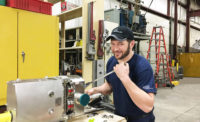

Any pump or valve considered for a processing system should bear the approval of 3-A Sanitary Standards Inc., McLean, Va., a non-profit organization that develops uniform standards and practices.
A well-designed pump or valve allows for complete and efficient cleaning in place, or CIP. That means all surfaces, including wetted elastomers. When evaluating pumps and valves, look for designs that have no dead zones, sharp corners or other places where organic materials can set up unmoved.
It is important to choose proper seal materials and elastomers. In fluid milk plants that also process juices and other non-dairy beverages, a plant manager needs seals that are compatible with all product ranges. The manager should choose the seal that stands up to the most demanding product. A silicon carbide double seal may be necessary for abrasive or sticky products. For example, a specifier might recommend a silicon carbide/silicon carbide seal for concentrated whey. But for fluid milk transfer, a carbon single seal might be suitable.
EPDM (ethylene propylene diene Monomer) is said to be the most versatile elastomer for pumps and valves because the material is resistant to most fluids used in a dairy processing plant, as well as to ozone. EPDM has a wide temperature range, which makes it very good as a standard. Exceptions to the standard include combinations of high temperatures, fat content over 30-40% and highly abrasive or acidic products. There are several options when choosing elastomers and it’s always a good idea to consult an application specialist about a specific process or product parameters. Because of thermal expansion and contraction and pressure changes in a processing system, select pumps and valves that are designed with metal-to-metal contact around seal surfaces for defined compression of elastomers. This will limit expansion and contractions of the elastomer and provide maximum seal life.
The right pump for the application
For basic transfer of product and moving product through a process line, a centrifugal pump is often the best solution when the product is of low viscosity and has a very-low percentage of solids (or solids that are very small in size). With the rise in energy costs and the push for environmentally-friendly products, many processers use high-efficiency centrifugal pumps for these applications. The more efficient the pump, the less energy is consumed. With the Energy Independence and Security Act of 2007 now in effect, dairies have a heightened awareness of pumping efficiency.
A rotary positive displacement pump with a circumferential piston is well-suited to move fluids and solids with minimal damage. Because the circumferential piston pump can handle very thin liquids, it is used in lines with multiple different products. The ability for the circumferential piston pump to handle low viscosities without losing efficiency also translates into energy-cost savings.
Most fluid milk applications can be handled with a centrifugal pump, sometimes using an inducer for tough suction conditions. Other applications can be handled using a positive displacement pump.
The majority of cheese and butter applications require a positive displacement pump. A large inlet port mounted to an auger feed will minimize restrictions of entering the high-viscosity liquids into the pump. Normally, a positive displacement pump also is used to handle ice cream mix. Cultured product requires gentle handling, so a large pump with increased pump inlets is the general rule of thumb.
Sorting out valves
Economics, function and planned maintenance requirements are important when choosing a valve. The best valve is one that is reliable, easy to maintain and has a low total cost of ownership. An unreliable valve can result in line stoppages, thus requiring cleaning and sterilization, which takes time away from producing salable product.
There are many valve options, and they are all process dependent. Aseptic and hygienic process valves are used in applications where the highest of sanitary requirements are needed. These valves allow for the ability to sterilize and run a completely aseptic process. The valves also have the benefit of being easy to maintain and are highly modular so that they adapt to multiple application requirements.
The different configurations of rising-stem valves (including single seat, mixproof and double seal) are all used in the dairy industry. Regulatory agencies write regulations around this valve design. The flexibility of the different configurations, their cleanability and their serviceability are the main reasons why some call this the best valve for the dairy processor.
Look for a valve design that does not allow product to be trapped and become stagnant. Valves should not have any crevices or deadlegs in their housing design. Product specifiers should avoid seat and stem gaskets with an O-ring type design because these are prone to rolling as the valve stem moves, which allows product to get behind the gaskets, making the valve harder to properly clean. As for gaskets, a metal-to-metal V-ring design is the optimum because wear is greatly reduced, even when there are large temperature differences across the valve. This ensures longer life of the gasket.
To ensure against cross-contamination, use a mixproof valve. This valve is designed so that CIP fluids in one housing cannot contaminate product in the opposite housing. Mixproof valves are generally used where automation and numerous product changeovers are critical to the system design. Processors of multiple fluid products (such as milk, juice and tea) benefit from using mixproof valves because they allow for the running of many products simultaneously without the fear of any cross contamination of products or product and CIP. Some vessels can be filled, some emptied and some cleaned, all at the same time. Mixproof valves in a multiproduct environment allow for a fully sanitary, flexible and automated process design solution. They protect against the mixing of unlike products, including allergens.
For processing fluid milk, consider a single-seat mixproof valve. Cheese processors use a long-stroke single seat valve or PMO-approved long-stroke mixproof valves with a larger valve opening to allow for the gentle processing of cheese particulates and curds. Aseptic and single-seat PMO mixproof valves are suitable for cultured products. (PMO is the Pasteurized Milk Ordinance.)
Accessories for valves
Valve feedback units help control the valves through the plant’s PLC. This allows a central location to control the valves in a system, further increasing efficiency. Feedback is required for PMO mixproof valves. Control technology is a smart choice for single-seat valves because it allows an operator to confirm valve actuation and that the process is ready to start. New designs provide options such as local visual indication, valve speed controls or maintenance intervals. The ability to communicate with valves from a central location and in a recorded database gives plant managers the advantage of increasing production efficiency and enhancing the safety of the product and operators.
Best practices for cleaning
After a product run, valves should be cleaned-in-place as quickly as possible to prevent product residue from drying or hardening. During the CIP sequence, the valves seats should be pulsed repeatedly to allow the solution to clean underneath the seats and inside the vent cavity of mixproof valves. Mixproof valves provide complete product protection at all times (including during seat lifting), so operators can receive maximum security when there is product and CIP liquids in opposite lines.
The rule of thumb is to have a flow velocity of a minimum of 5 feet per second of CIP liquid. CIP pumps can save maintenance time and prevent equipment damage. Continual disassembly of a pump for cleaning not only costs valuable downtime, but it also can damage pump parts to the point where they are no longer sanitary and need to be reconditioned.
A process engineer can determine the proper CIP regimen in terms of times, temperatures and chemical concentrations based on the type of product being processed, the run time and the frequency of cleaning. This is periodically tested when the installation is commissioned to ensure proper cleaning is achieved. This is normally monitored by QA results. Once the CIP regimen is determined, controls on valves make the process repeatable. There are control modules that can reduce the amount of water and chemicals needed to clean the valve, which are useful in areas where water is scarce.
Sanitary single-seat valves and PMO-approved mixproof valves are designed to process fluid milk products as well as other beverage products. It is critical to have a stringent CIP regimen when switching the production run to a different product in order to avoid cross-contamination from leftover product residue.
Buy new or rebuild?
Rebuilt and reconditioned equipment is available from manufacturers and third-party providers. Manufacturers advise against rebuilding a valve from third-party parts. If such parts were not accurately manufactured, they can cause premature failure. Use of third-party parts can also lead to a loss of warranty from the manufacturer.
Plant managers should be careful when considering buying used equipment. It might not meet the latest 3-A requirements and parts may be difficult to find. Managers are in the dark about how that product was used and maintained during its first life.
Equipment makers do offer their own rebuilt and remanufacturing programs. This allows a facility manager to reduce the cost of ownership and extend the life of the equipment. The manager might want to use a reconditioned pump or valve as a backup. Ask the manufacturer if it warrants (and for how long) rebuilt products.
A preventative-maintenance schedule should be developed for the high-wear parts of valves. This proactive approach will prevent downtime in production if a valve part fails and the spare parts are not in stock. Another approach is to have a few complete valve inserts as spares so that these can be dropped into the line right away if a part fails. The production line keeps running, and the failed valve can be repaired later.
This article was written by Dairy Foods chief editor Jim Carper from information supplied by Jonathan Clem, Aseptomag NA; Randy Verges, Fristam Pumps USA; Dave Medlar, GEA Mechanical Equipment US; John M. Weaver, Lee Industries; Eric Cummings, Ross Controls; Jim LeClair, Chris Sinutko and William Rice, SPX Flow Technology; Jeremy Hauser, Südmo North America; and Keith Ortman, Tetra Pak.
10 Things to Know About Valves
1. Know how valves work, how to install them and how to maintain them.
2. Choose valves with a sanitary design, meaning they are easy to clean.
3. A mixproof valve should allow no possibility of cross-contamination, even with damaged gaskets or no seat gaskets.
4. Look for valves that require minimal CIP liquid for cleaning. This will reduce demands on the environment.
5. Select low-maintenance valves and develop a preventative-maintenance schedule.
6. Have spare parts on hand or know that they are readily available from the manufacturer or its distributor.
7. Reduce the number of parts you need to stock by choosing valves with modular designs, including those with interchangeability of control modules, actuators and housings.
8. Selecting PMO-compliant mixproof valves allows for more flexibility in processing and cleaning.
9. Stay up-to-date with new valve technologies.
10. Ask the manufacturer about its support and warranties.
10 Things to Know About Pumps
1. Choose the right pump for the application. Ask an application specialist to size pumps.
2. Specify pumps that meet all current standards and regulations.
3. The more efficient the pump, the less energy it will use.
4. Do not run a pump dry. It will ruin the seals. Automatic control systems do not always catch this in time.
5. Buy a pump that is designed to be easy to clean in place. The more cleanable a pump, the less product risk.
6. Watch out for pressure shock, especially from a downstream valve closing. It can bend shafts, rub impellers or rotors and blow off covers.
7. Know who to call if the pump fails or if your applications and needs change.
8. Make sure spare parts are readily available.
9. Serviceability is critical. How easy or difficult is it to service by your personnel? Do you need special tools to service the pump?
10. Ask the manufacturer how long it has been in the sanitary pump business.


